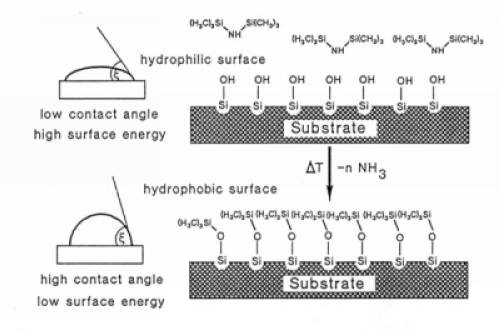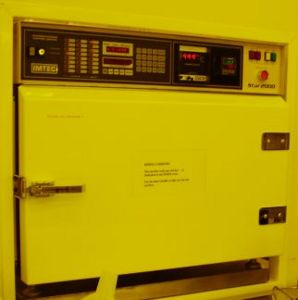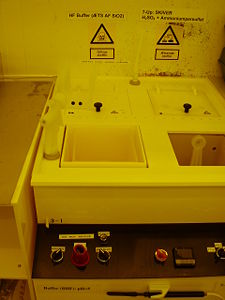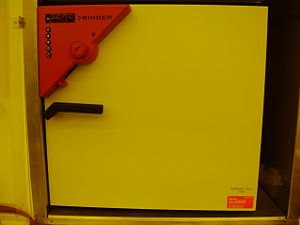Specific Process Knowledge/Lithography/Pretreatment: Difference between revisions
Created page with "==Pretreatment== ===BHF dip=== *For substrates that are plain Si wafer: Give it 30s in the BHF + 5 min in water right before you spin resist on it. This removes the native ox..." |
No edit summary |
||
| Line 1: | Line 1: | ||
==Pretreatment== | ==Pretreatment== | ||
All surfaces can be divided to hydrophilic or hydrophobic surfaces, where the oxidized surfaces such SiO2 or surface with native oxide formation on Si or Al substrates consider to be hydrophilic and have very bad wetting with hydrophobic resist. | |||
Therefore it is very important to do the pretreatment step before the spinning. Here we will give an overview of treatment which Danchip recommend to render the surface hydrophobic. | |||
==HMDS== | |||
The chemical treatment with Hexamethyldisilazane (HMDS)before the spin coating can be used to promote the adhesion for photoresist. | |||
Here is a schematic overview of HMDS treatment of silicon-oxide surface. | |||
[[Image:HMDS.jpg|500x500px|thumb|left|Priming of oxide-forming substrates by HMDS treatment.]] | |||
<br clear="all" /> | |||
[[Image:HMDS1.JPG|300x300px|thumb|The HMDS oven is placed in Cleanroom 3.]] | |||
At Danchip we use Star2000 model from IMTEC to do prime vapor deposition of hexamethyldisilizane(HMDS)under the special conditions: low pressure and hight chamber tempurature. The result of the dehydration bake and HMDS prime is that the wafers become hydrophobic after the treatment. | |||
'''Overview of the main recipe:''' | |||
1. Dehydration and purging nitrogen for ca. 12 min. | |||
2. Priming of HMDS vapor ca. 7 min. | |||
3. Purging prime exhaust for ca. 5 min. | |||
4. Backfill, return to atmosphere pressure ca. 3. min. | |||
<br clear="all" /> | |||
===Overview of HMDS process=== | |||
{| border="2" cellspacing="0" cellpadding="4" align="left" | |||
! | |||
! Pretreatment in HMDS oven | |||
|- | |||
|'''General description''' | |||
|Promotion of photoresist adhesion | |||
|- | |||
|'''Chemical solution''' | |||
|hexamethyldisilizane | |||
|- | |||
|'''Process temperature''' | |||
|150 <sup>o</sup>C | |||
|- | |||
|'''Process time''' | |||
|27 min. | |||
|- | |||
|'''Batch size''' | |||
|1-15 wafers at a time, more then 1 batch a time | |||
|- | |||
|'''Size of substrate''' | |||
|2"-6" wafers | |||
|- | |||
|} | |||
<br clear="all" /> | |||
==BHF== | |||
[[Image:BHF_RR3.jpg|300x300px|thumb|BHF: positioned in cleanroom 3]] | |||
Another commonly used method to render the surface of silicon wafers hydrophobic is the dilute HF dip. | |||
BHF is mostly used to do pretreatment step for new Si wafers. The native dioxide layer will be removed during 30 sec etching and in this way we will promote the resist adhesion on the Si substrates. We recommend to spin resist asap after the procedure. | |||
<br clear="all" /> | |||
==250 C oven for pretreatment== | |||
[[Image:Oven_250_degrees_for_pretreatment_cr3.jpg|300x300px|thumb|250 degrees oven for pretreatment: positioned in cleanroom 3]] | |||
The oven is typically used for pretreatment of Si and glass substrates to promote the resist adhesion. We recommend to place the wafers in metal carrier in the oven at least for 4 hours, better during the night, and spin the resist on them asap. | |||
Revision as of 11:03, 30 May 2013
Pretreatment
All surfaces can be divided to hydrophilic or hydrophobic surfaces, where the oxidized surfaces such SiO2 or surface with native oxide formation on Si or Al substrates consider to be hydrophilic and have very bad wetting with hydrophobic resist.
Therefore it is very important to do the pretreatment step before the spinning. Here we will give an overview of treatment which Danchip recommend to render the surface hydrophobic.
HMDS
The chemical treatment with Hexamethyldisilazane (HMDS)before the spin coating can be used to promote the adhesion for photoresist.
Here is a schematic overview of HMDS treatment of silicon-oxide surface.


At Danchip we use Star2000 model from IMTEC to do prime vapor deposition of hexamethyldisilizane(HMDS)under the special conditions: low pressure and hight chamber tempurature. The result of the dehydration bake and HMDS prime is that the wafers become hydrophobic after the treatment.
Overview of the main recipe:
1. Dehydration and purging nitrogen for ca. 12 min.
2. Priming of HMDS vapor ca. 7 min.
3. Purging prime exhaust for ca. 5 min.
4. Backfill, return to atmosphere pressure ca. 3. min.
Overview of HMDS process
| Pretreatment in HMDS oven | |
|---|---|
| General description | Promotion of photoresist adhesion |
| Chemical solution | hexamethyldisilizane |
| Process temperature | 150 oC |
| Process time | 27 min. |
| Batch size | 1-15 wafers at a time, more then 1 batch a time |
| Size of substrate | 2"-6" wafers |
BHF

Another commonly used method to render the surface of silicon wafers hydrophobic is the dilute HF dip.
BHF is mostly used to do pretreatment step for new Si wafers. The native dioxide layer will be removed during 30 sec etching and in this way we will promote the resist adhesion on the Si substrates. We recommend to spin resist asap after the procedure.
250 C oven for pretreatment

The oven is typically used for pretreatment of Si and glass substrates to promote the resist adhesion. We recommend to place the wafers in metal carrier in the oven at least for 4 hours, better during the night, and spin the resist on them asap.
